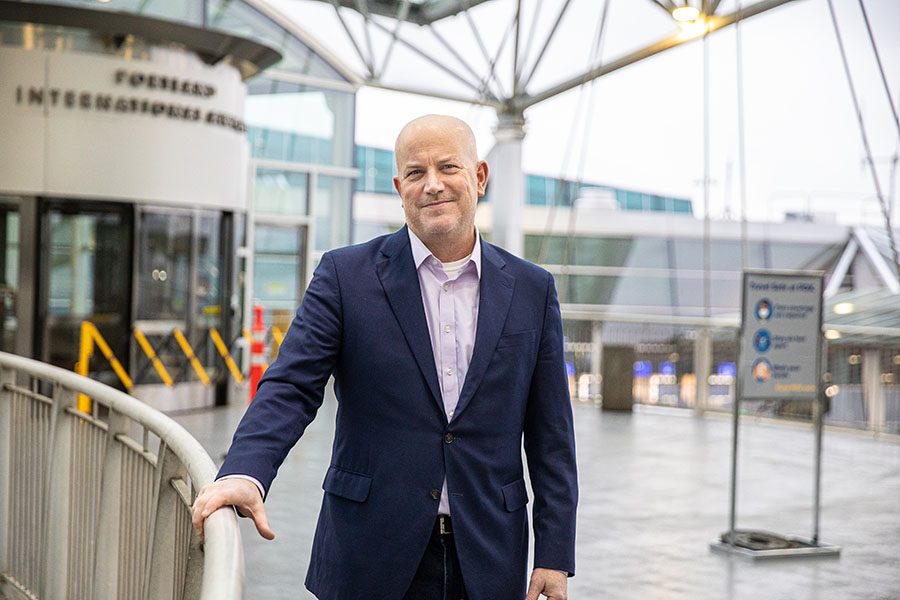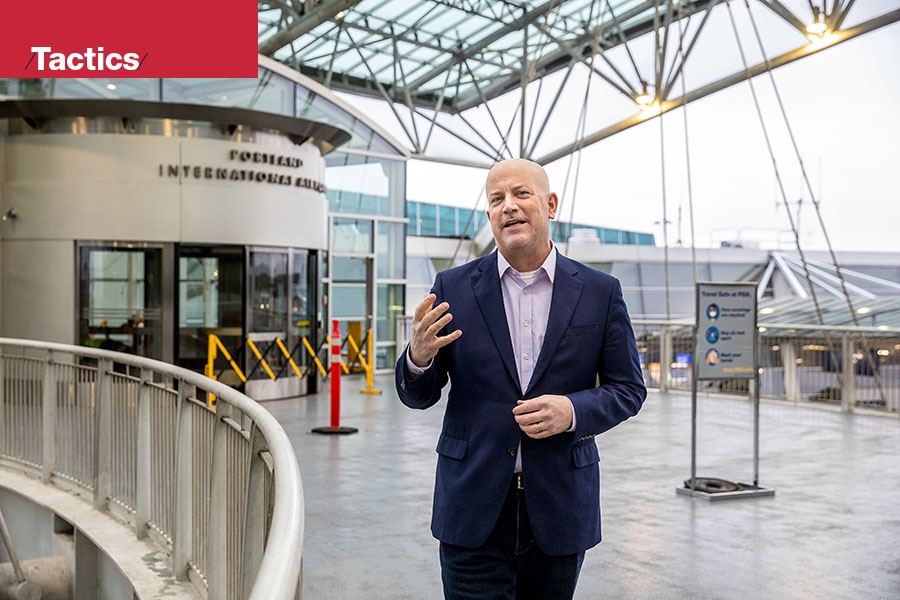The executive director of the Port of Portland discusses his new property development strategy and what it is like to expand the airport while passenger numbers have fallen off a cliff.
It is arguably one of the most turbulent times in the history of the Port of Portland, the operator of Portland International Airport. Commercial air travel saw its biggest decline in the history of the sector in 2020. At the same time, the airport is in the middle of a multibillion-dollar refurbishment and expansion project that will add new gates and a new main terminal.
Curtis Robinhold, executive director of the Port of Portland, discusses why the airport expansion will be worth it. He also reveals how the port, the largest owner of industrial land in Oregon, is changing its property development strategy in light of the social inequities that the coronavirus pandemic has exposed.
This interview has been edited for length and clarity.
What impact has the decline in air-passenger travel had on your business?
At the end of March, we were down 95%. We saw decent incremental return to travel in the summer and even into the fall. But with the resurgence of the virus in November and December, we are running at 30% of what we were a year ago. At some point, shutting down entirely is easier for us because you can turn off all your costs as well. That 70% decline in commercial aviation hits across the board; it is not just air travel. You see that ripple through all businesses across the airport: parking, rental cars, food and beverage. That has been a real struggle for us and our business partners.
When do you expect air travel to returnto pre-pandemic levels?
People are not going to get on planes in any real numbers until we have beaten the pandemic. That means vaccines and a change in personal behavior. It means a change in the way we do business. Much like post-9/11, what it meant to get on an airplane changed. That jolt to the industry was worked through relatively quickly: the scanning and lack of access to gates for non-passengers, not wearing shoes.
Those things changed everything about the experience. But people got used to it. The same will happen in aviation. We will adjust to the way we get on a plane. We are working through the health-related processing requirements: whether we have health-screening areas, quarantine areas. I suspect we will be through coronavirus in the next year or so. But the threat of the next virus will mean we will simply have to adjust.
What new rules do you expect will shape air travel in the future?
What would be most helpful and what we have not seen yet is national leadership that says: “All airports will behave this way.” That would help us create a more seamless process, regardless of where you are flying from. Right now, there is a mish-mash of national policy, which is reflected in how we are handling vaccinations but also in what airports can and can’t do. We are looking forward to the day when there is a more unified approach.
What unified air-passenger traffic rules are most needed?
What requirements do you have for passengers for testing for international and domestic flights? What screening requirements do you have at the airport? What do airports do if they have a positive case? What do airlines do in terms of requirements for mask wearing? What happens if someone refuses to wear a mask on an airplane? Is that up to the pilot, the flight attendant, the airline? If I am flying to New York, when I get on at PDX, there should be a set of standards that I have to follow.
The new Concourse E at the airport opened this summer during the biggest-ever decline in commercial air traffic. How will that investment impact you financially?
Concourse E was a $215 million extension. It is now the new home of Southwest Airlines. They moved up from Concourse C. It is actually a relatively small part of a larger $2 billion construction program that we are calling PDX NEXT. It will include a new Concourse B, a new rental-car center and parking additions. The big one is the new main terminal — a $1.5 billion project — all of which is paid for by the airlines and travelers. A small part is funded by what airlines get out of ticket sales, which is then paid to us to service debt. It will be challenging.
We got some CARES funding last summer from the federal government. We are in the most recent round of stimulus as well. That will help with our debt service. We have an agreement from the airlines to cover our costs. That means that as long as we are on budget, they will stick with us through this construction.
PDX NEXT is a six-year, $2 billion effort. We are in the third year. There will be a lot of construction happening in 2021. We believe this will be necessary for our growth in the future. When people return to travel, they will see the bits that are new, but they will also experience some disruption over the next few years as we work on the main terminal, which will be open in 2024.
It is a lot, but we also feel like, in some ways, it is easier to do when you have 30% of your historic number of passengers coming though. It is also necessary for safely and capacity reasons — we couldn’t stay at our old size for long.

To what extent has the demand for air freight offset the decline in air-passenger traffic?
Air cargo has been a bright spot for aviation. Our air cargo operations are projected to be up 9% year-over-year. The increase is linked to e-commerce and likely by movement of PPE and what we expect will be the movement of COVID-19 vaccine. It is not many flights. While 9% is important, it pales in comparison to the number of flights that we see for passenger travel.
That being said, Cathay Pacific, which is our large international cargo service, is still doing three weekly 747 freighters from PDX to Hong Kong. When summer comes, they can crank up the number of flights from Oregon for mostly agricultural products — blueberries, raspberries and cherries, and crab when it is in season, which go out to Asia. We expect that air cargo to continue to be strong.
It does not fill the gap in revenue to the Port, but we are happy about being able to maintain those connections for Oregon businesses trying to do business abroad.
How has COVID-19 impacted your marine-freight division?
There were some early disruptions to the supply chain. We felt that mostly in March and April. But volumes continued to improve over the summer and fall. We ended the year very strong. Our total tonnage for the year was up 10% over 2019. A better indicator of improvement is containers. We re-established container service a year ago.
We handled 30,000 containers in 2020. We have had good cooperation from SM Line, which is the carrier, and from the longshoremen. In October 2020 we handled 3,800 containers on SM Line vessels, which is the highest since 2015.
You are also a hub for importing and exporting cars. How is that business compared with previous years?
Exports were impacted by the supply-chain issues and economic impacts associated with the pandemic. Imports and exports were down 26% in 2020. It is a relatively large business. People are surprised to learn that we are the largest auto port on the West Coast. We handled 29,000 autos in October, which was the highest volume since July 2019.
What do you see as the highest future growth area of your business?
As an organization, we are focused on how we recover in a way that reflects shared prosperity more than in the past. Over the 130-year history of the Port, we have benefited mostly existing and larger businesses. We are trying to take the opportunity to rethink our role in the community. We are leaning into what we call a shared-prosperity agenda: thinking about how we maximize benefits to Black, Indigenous, people-of-color and low-income communities.
We are looking for opportunities to leverage things we do well. For example, we are a strong industrial property developer. We have put a lens on who is really benefiting from that development. We have a forward-thinking project in Gresham where we established criteria for property development for Gresham Vista [Business Park]. That criteria targets job creation of a certain value — essentially middle-income jobs instead of the lowest common denominator.
We have done a lot of logistics development in the past — most of those jobs come in at minimum or slightly above minimum wage. We are thinking more about how we get more manufacturing jobs, middle-income jobs.
What development projects do you see benefiting the community the most?
We did a big deal with Amazon out in Troutdale. It built a massive new facility, creating 2,000 jobs. But those jobs are starting at $15.50 an hour. It is a lot of jobs, but you are not lifting people out of poverty with those jobs.
A good example of what we hope to do more of is the De Beers subsidiary in Gresham. They manufacture artificial diamonds. There are fewer jobs — 60 or so to start. But the average income of those employees is $65,000. Now you are talking about people who are in a position where they can access home ownership, wealth creation and a longer-term story. High-value manufacturing jobs are a great example of where we see opportunities.
Why this new direction?
It is really these three tiers of crisis over the past year that have really jolted us. We have been doing a lot of work on equity, diversity and inclusion over the past couple of years. But then there was the health crisis that disproportionately hit low-income populations and populations of color, coupled with the economic recession. We looked at the confluence of these three events — pandemic, economic recession and movement for equal justice — and we started to think about what our role is here.
We are also getting a bit smaller at the Port. The financial pressure of the loss of aviation business is creating pressure on us. As a leader, I asked myself how we can come out of this. Is it by looking backward and trying to get back to where we were or to where we want to be? It is a shift to think about what the right role is for us and how to create the kind of community we want, instead of the kind of community we used to have.
The pandemic has also gotten people to think more about an economic recovery grounded in environmental sustainability. Are you factoring that into your future growth?
We are. It has become part of the Port’s DNA. We use all renewable power out of the airport. We are transitioning away from ground-source diesel equipment. We have compressed natural gas buses. We are doing everything in our power to manage environmental impact. The big question is what do you do about the carbon impact of commercial aviation? That is something a single airport cannot fix.
We clearly need national, and ideally global, climate action. We need national policy to make all airports and airlines move in one direction at the same time. That means carbon pricing, which is clearly in our future. We just need to get moving on policy. I think the Biden administration is likely to come in strong on getting moving on policy. Commercial aviation has to be part of that.
To subscribe to Oregon Business, click here.


